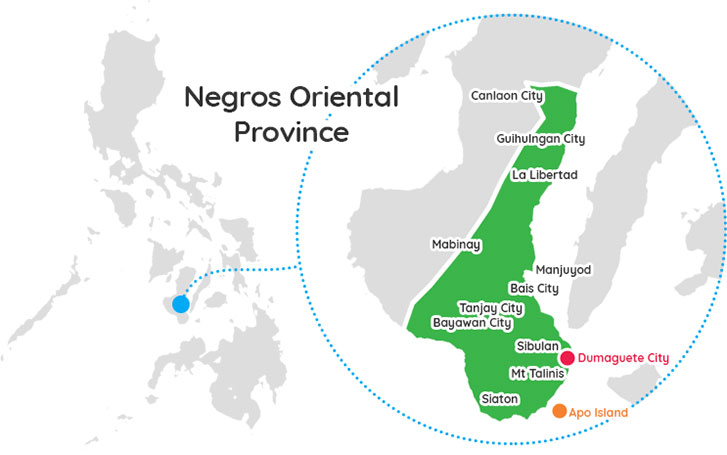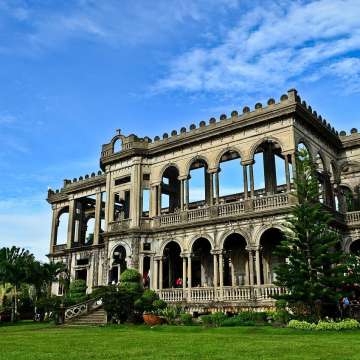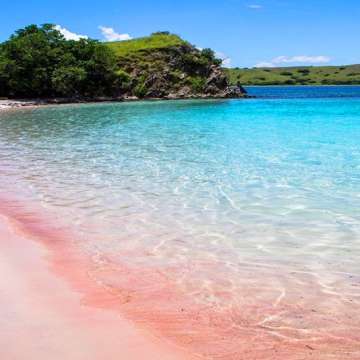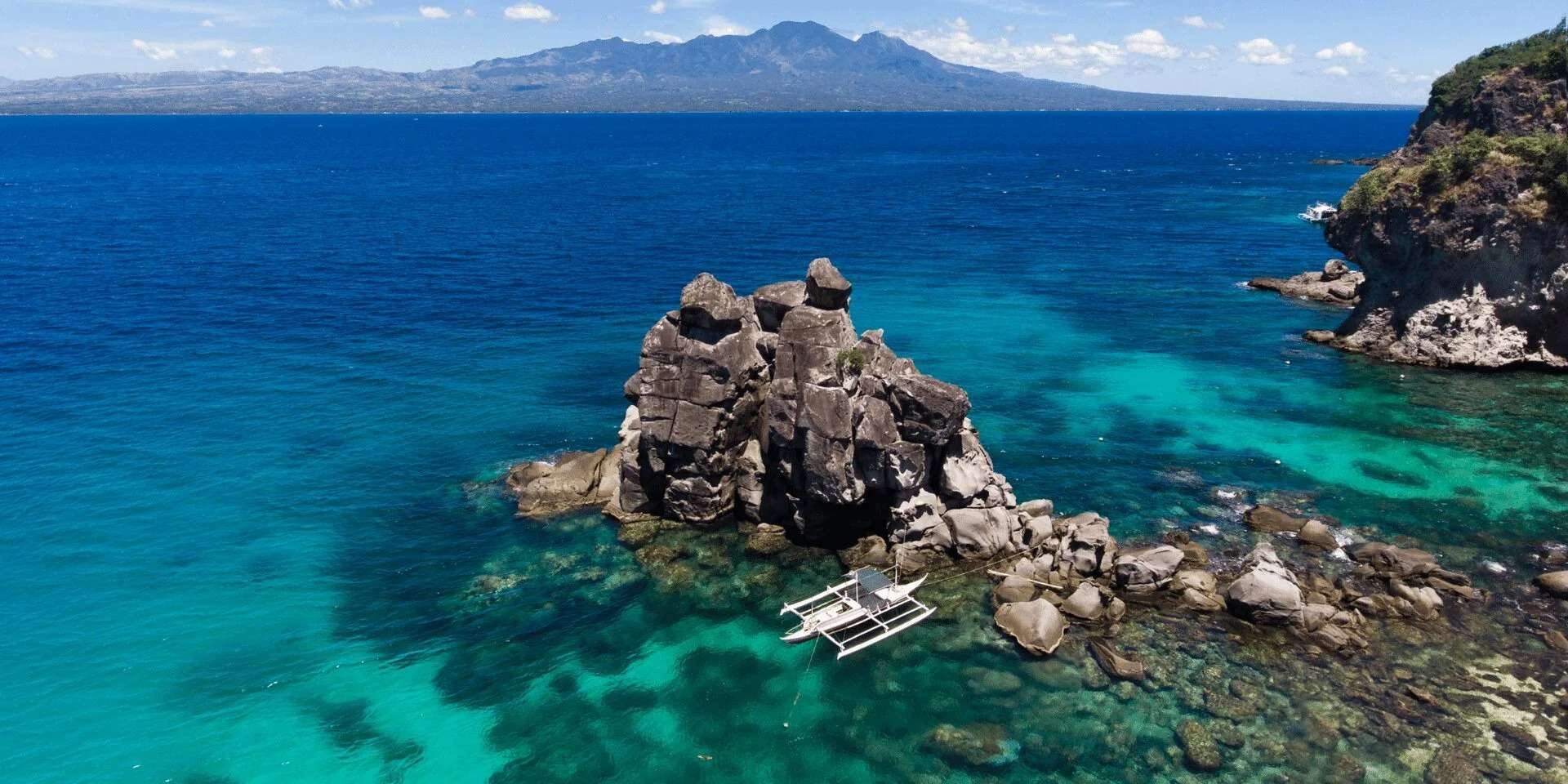About negros oriental

Negros Oriental, officially the Province of Negros Oriental, is a province in the Philippines located in the Central Visayas region. Its capital is the city of Dumaguete. It occupies the southeastern half of the large island of Negros, and borders Negros Occidental, which comprises the northwestern half. It also includes Apo Island, a popular dive site for both local and foreign tourists.
Negros Oriental faces Cebu to the east across the Tañon Strait and Siquijor to the south-east (which happened to be part of the province before). The primary spoken language is Cebuano and the predominant religious denomination is Roman Catholicism. Dumaguete is the capital, seat of government and most populous city of the province. With a population of 1,432,990 inhabitants, it is the second most-populous province in Central Visayas after Cebu, the fifth most-populous province in the Visayas and the 19th most-populous province of the Philippines.
History
Negros, the largest island in the Visayas, is believed to have once been part of a larger landmass that was cut off by rising waters at the end of the last ice age. Among the early inhabitants of the island were the Negritos and the Austronesians, and later the Han Chinese, who are mainly merchants. They called the island "Buglas", a native word which is believed to mean "cut off".
Spanish explorers on the expedition of Miguel Lopez de Legazpi first came to the island in April 1565. Legazpi dropped anchor in Bohol and sent his men to scout the island. Because of the strong currents of the Tañon Strait between Cebu and Negros, they were carried for several days and forced to land on the western side of the island. They reported seeing many dark-skinned inhabitants, and they called the island "Negros" (Negro means "black" in Spanish). The island was sparsely settled at the time, except for a few coastal settlements including Ilog and Binalbagan. In 1571, Legaspi assigned encomiendas on the island to 13 of his men. Augustinian friars began the Christianization of the island the next year. The island was administered as part of the jurisdiction of Oton until 1734 when it became a military district, and Ilog became the capital of the island. The capital was transferred to Himamaylan in 1795. Negros became a politico-military province in 1865 and the capital was transferred to Bacolod.
Due to its proximity to Mindanao, the southeastern coasts of Negros was in constant threat from Moro marauders looking for slaves, so watchtowers were built to protect the Christian villages. The Moro raids and Negros Oriental's distance from the Negrense capital of Bacolod, induced 13 Recollectionist priests to petition for the division of the island in July 1876. The island of Negros was then divided into the provinces of Negros Oriental and Negros Occidental by a royal decree executed by Governor General Valeriano Weyler on January 1, 1890. Dumaguete was made the first and only capital of Negros Oriental. In 1892, Siquijor became a part of Negros Oriental, having previously been administered by Spain under the politico-military province of Bohol.
The Philippine Revolution reached Negros in 1898, disrupting government functions but without extreme violence and bloodshed. Revolutionary troops in the island were composed mostly of farm labourers and other prominent people of the province of Negros Oriental, who were organized and led by Don Diego de la Viña. The Spanish colonial government in Dumaguete and the rest of the island was overthrown on November 24, 1898. Later, the Negros Occidental area under the leadership of Gen. Araneta, along with the Negros Oriental area under the leadership of Don Diego de la Viña, merged to form the Cantonal Republic of Negros, a separate government from the more familiar Malolos Republic established in Luzon.
In 1901, the Negros Oriental province was reorganized by the United States and a civil government was established with Demetrio Larena as governor. The American government made Siquijor a "sub-province" of Negros Oriental. Negros Oriental became a province under the American civil government on March 10, 1917, through Act 2711. In 1934, Negros Oriental became a corregimiento, a separate military district. Under the American colonial government, transportation infrastructure was developed with improvements of roads and new bridges.
During World War II, both Negros provinces were invaded by Imperial Japanese forces, resorting many residents to flee to the inland mountains. Negros Island was liberated by combined Philippine & American troops with the local Negrense guerillas attacking the Japanese on August 6, 1945. The 7th, 73rd, 74th and 75th Infantry Divisions of the Philippine Commonwealth Army were established from January 3, 1942, to June 30, 1946, and the 7th Constabulary Regiment of the Philippine Constabulary was active from October 28, 1944, to June 30, 1946, at the Military General Headquarters in Negros Oriental. They started the engagements of the Anti-Japanese Imperial Military Operations in Negros from 1942 to 1945 against the Japanese Imperial forces.
Listings in negros oriental
More Provinces

negros occidental
Negros Occidental is a province in the Philippines located in the Western Visayas region. Its capital is the city of Bacolod. It occupies the northwestern half of the large island of Negros, and borders Negros Oriental, which comprises the southeastern half. Known as the "Sugarbowl of the Philippines", Negros Occidental ...read more

northern samar
Northern Samar is a province in the Philippines located in the Eastern Visayas region. Its capital is Catarman and is located at the northern portion of the island of Samar. Bordering the province to the south are the provinces of Samar and Eastern Samar. To the northwest, across the San ...read more


